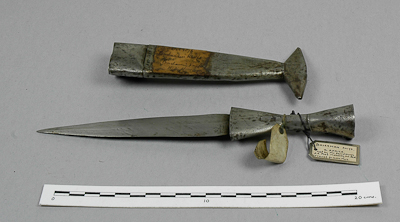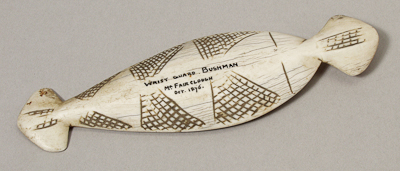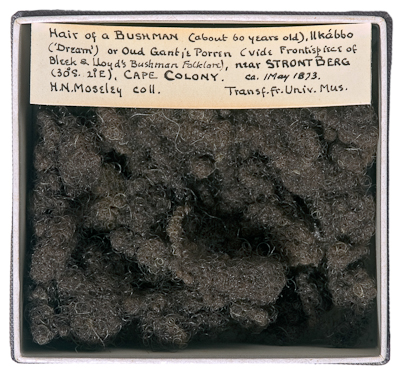Chapter XXV 'On the Craniology of the Bushmen' from Scientific Papers and Addresses, vol 1, George Rolleston, 1884.
Please note that the human remains mentioned in the following paper are not, and have never been, part of the Pitt Rivers Museum's collections
 1887.1.657 Knife from South Africa, collected by Fairclough donated by Moseley to the University Museum, now in PRMThe following human bones--viz. four skulls, six lower jaws, four cervical vertabrae, one large and one small sized scapula, two small sized and fragmentary humeri, a fragment of a very slight but adult ulna, four cervical vertebrae, and five more or less fragmentary ribs--have been put into my hands by Mr C.G. Oates, with information to the effect that they had belonged probably to a Bushman horde massacred somewhere between the Tati and Romaqueban rivers in S. lat. 20 [degrees] 54', and long. 27 [degrees] 42'. With these human bones came some bones of Equus ... also of a large ruminant ... and one smaller ... and part of the skull of an ostrich ... and, later, the feet-bones of an elephant .... All these bones had been collected by my former pupil, Mr Frank Oates, of Christ Church, Oxford. ... These six lower jaws are by far the most important bones as regards the question of the nationality of the entire 'find.' If, indeed, these half-dozen lower jaws had been brought to me with no other accompaniments and with no other information than that they had all been brought from one spot in Africa, I think I should have been justified in saying that they had belonged to no other known African race than the Khoi-Khoin, or its central African representative, the Akka. For they all six alike show the following distinctive and eminently significant peculiarities--viz. lowness of coronoid process, smallness of absolute size, and all but complete obsolescence of chin. ... It is, or should be, a commonplace among craniographers that, whilst the lower jaw is a more important bone for their purposes than any other single bone of the skeleton, and even than the pelvis itself, it is often more distinctive, if not more valuable, than at least the entire calvaria. ... as I can aver from my knowledge of the collections in the Oxford University Museum, it is by no means always possible to distinguish either such brachycephalic Negro skulls ... from Bushman skulls ... it is within my knowledge always possible to do so if the skulls under comparison are in possession of the lower jaws belonging to them.
1887.1.657 Knife from South Africa, collected by Fairclough donated by Moseley to the University Museum, now in PRMThe following human bones--viz. four skulls, six lower jaws, four cervical vertabrae, one large and one small sized scapula, two small sized and fragmentary humeri, a fragment of a very slight but adult ulna, four cervical vertebrae, and five more or less fragmentary ribs--have been put into my hands by Mr C.G. Oates, with information to the effect that they had belonged probably to a Bushman horde massacred somewhere between the Tati and Romaqueban rivers in S. lat. 20 [degrees] 54', and long. 27 [degrees] 42'. With these human bones came some bones of Equus ... also of a large ruminant ... and one smaller ... and part of the skull of an ostrich ... and, later, the feet-bones of an elephant .... All these bones had been collected by my former pupil, Mr Frank Oates, of Christ Church, Oxford. ... These six lower jaws are by far the most important bones as regards the question of the nationality of the entire 'find.' If, indeed, these half-dozen lower jaws had been brought to me with no other accompaniments and with no other information than that they had all been brought from one spot in Africa, I think I should have been justified in saying that they had belonged to no other known African race than the Khoi-Khoin, or its central African representative, the Akka. For they all six alike show the following distinctive and eminently significant peculiarities--viz. lowness of coronoid process, smallness of absolute size, and all but complete obsolescence of chin. ... It is, or should be, a commonplace among craniographers that, whilst the lower jaw is a more important bone for their purposes than any other single bone of the skeleton, and even than the pelvis itself, it is often more distinctive, if not more valuable, than at least the entire calvaria. ... as I can aver from my knowledge of the collections in the Oxford University Museum, it is by no means always possible to distinguish either such brachycephalic Negro skulls ... from Bushman skulls ... it is within my knowledge always possible to do so if the skulls under comparison are in possession of the lower jaws belonging to them.
 2003.5.1 Wrist guard from South Africa, collected by Fairclough donated by Moseley to the University Museum, now in PRMFor purposes of comparison with these three presumably Bushman crania, I have had three other crania at hand from the University Museum, of the genuineness of which there can be little doubt. One of these was presented to the University Museum by the late and much lamented dr W.H.J. Bleek, to whose labours on elucidating the language and rescuing the folklore of the Bushman tribe from perishing we owe so much. This skull, which was brought to England by Mr Alfred Hughes of St Asaph, beaars a label 'Eland's Been, nr. Schietfontein, Bushman's skull,' and was handed over to me by that gentleman at the desire of Dr Bleek. The second skull came into my hands through the kindness of W.G. Marshall, Esq., of Colney Hatch, having been entrusted to him by George Dunsterville, Esq., of Port Elizabeth, Algoa Bay, S. Africa, who was for some years surgeon to the hospital at Port Elizabeth. This skull which, like the preceding, belonged to an exceedingly old man, carries the following labels:--'From the Transvaal, S. African Republic;' 'Of an original Bosjesman, a tribe of small Hottentots, now nearly extinct; over age; height, 4 ft 4 in.' The evidence for the authencity of the third Bushman cranium, which was in the University Museum previously to the arrival of Mr. Oates's consignment, is even more irrefragable. This cranium was procured for the University through the kindness of H.N. Moseley, Esq., F.R.S. from Mr. Fairclough of Cape Town, and with the cranium came a knife, a poison-pot, a quiver, a poisoned arrow, and an ivory wrist protector which had belonged to the owner of the skull. This skull belonged to a man past the middle period of life, and is remarkable for its absolute height ... [1]
2003.5.1 Wrist guard from South Africa, collected by Fairclough donated by Moseley to the University Museum, now in PRMFor purposes of comparison with these three presumably Bushman crania, I have had three other crania at hand from the University Museum, of the genuineness of which there can be little doubt. One of these was presented to the University Museum by the late and much lamented dr W.H.J. Bleek, to whose labours on elucidating the language and rescuing the folklore of the Bushman tribe from perishing we owe so much. This skull, which was brought to England by Mr Alfred Hughes of St Asaph, beaars a label 'Eland's Been, nr. Schietfontein, Bushman's skull,' and was handed over to me by that gentleman at the desire of Dr Bleek. The second skull came into my hands through the kindness of W.G. Marshall, Esq., of Colney Hatch, having been entrusted to him by George Dunsterville, Esq., of Port Elizabeth, Algoa Bay, S. Africa, who was for some years surgeon to the hospital at Port Elizabeth. This skull which, like the preceding, belonged to an exceedingly old man, carries the following labels:--'From the Transvaal, S. African Republic;' 'Of an original Bosjesman, a tribe of small Hottentots, now nearly extinct; over age; height, 4 ft 4 in.' The evidence for the authencity of the third Bushman cranium, which was in the University Museum previously to the arrival of Mr. Oates's consignment, is even more irrefragable. This cranium was procured for the University through the kindness of H.N. Moseley, Esq., F.R.S. from Mr. Fairclough of Cape Town, and with the cranium came a knife, a poison-pot, a quiver, a poisoned arrow, and an ivory wrist protector which had belonged to the owner of the skull. This skull belonged to a man past the middle period of life, and is remarkable for its absolute height ... [1]
I have ... to draw attention to a striking qualitative or morphological peculiarity observable in no less than three out of my six Bushmen crania; this being the presence either of a perfect, or of a rudimentary division of the malar bone into two distinct parts. ... When I add to these observations the fact that similar sutures have not within my knowledge and research been observed in other African crania of any of the varieties living on that continent, it will be seen that the presence of them in these skulls goes a considerable way, when coupled with other considerations, towards making it pretty certain that they were of Bushman nationality. Further investigation of the distribution and non-distribution of this most significant suture amongst the several typical races of men lends some additional force to this argument, and besides not a little suggestive as to other views. In the Oxford University collection of crania I have not found any traces of it amongst forty-seven Australian, nor amongst our five Tasmanian crania, nor amongst our Stone-age crania, a series well represented here. The only other race of indisputably pristine and very pristine habits, in which I have observed it to exist, is the Eskimo, and out of the large number of such skulls I have only noted it once, in the form of a unilaterally symmetrical fissure. The other skulls which this Museum contains possessing this suture either well or rudimentarily developed, are six in number. Four are presumably either of the Malay or of the Chinese race, as two were collected by Captain Elmhirst of the 9th Regiment, from the sea-shore of an island in the Chinese Seas, out of a great quantity which were lying about unburied, and were supposed to have belonged to Chinese pirates, and were finally presented to the University Museum by the Rev. H. Hansell, Fellow of Magdalen College; the third was a skull of a female Moro, collected in the mountains of Sulu, and presented by Captain Chimmo, R.N., whilst the fourth was purchased from Mr Cutter, the dealer in natural history specimens, as being a Borneo pirate. The other two are from Ceylon, one being a Tamil from Central Ceylon, presented by Mr B.F. Hartshorne, who was himself for a considerable time resident on the island, and has written upon its ethnology; the other being a 'Malabar.' [2] As the absence of this suture from the Zulu and Negro series gives additional importance to its presence in the Bushman, so its absence, which I have noted in a considerable number of Praearyan skulls, such as those of of the Coles and Moosahurs, procured for me by William Duthoit, Esq., D.C.L., [3] gives additional importance to its presence in 'Malabars,' 'Tamils,' Malays and Chinese. Of course future research may discover this suture in other races of mankind; as the matter stands at present I am tempted to think that there is possibly some significance in its having been noticed in the Eskimo, in the Bushman, in certain races of the Eastern Archipelago, and in Tamil skulls, as well as in the fact of its having been found to be absent in certain other skulls also of ancient races, such as the Kolarian and the Australian.
... The old view which ascribed a Mongolian origin to the Khoi-Khoin races is now pretty generally given up. A more important subject would, if I had space, be furnished me for discussion in the recent discoveries in Central Africa, which appear to point to the existence of kinship between the pigmy Akka and Obongo tribes and the Bushman. ... As regards the yellow hue of the skin, the likeness to the Mongolian races proper is perhaps less disputable, but with the skin we are bound to consider the hair, [4] the peculiarities of which, as seen in the Bushman, are as different from those seen in the Mongolian variety of mankind as it is possible for two varieties of human hair from the same area to be. ... it is needless to contrast the spirally contorted and tufted dark hair of the Hottentot or Bushman with the coarse wire-drawn straight black hair of the Mongolian or Eskimo. It is curious, however, if indeed not otherwise significant, that the Central African 'Bushmen,' if we may call them, of Ashango, occasionally bury their dead in a temporarily diverted stream-course, much as was done in the case of Attila ...
The Bushman race, as is well known, have strong proclivities in the direction of musical performances. The same however may be said of other priscan races as well as of them and the Mongolian and Kalmuck tribes, and we cannot therefore lay any weight upon this point of similarity.
The custom, however explained, which the Khoi-Khoin races have of cutting off one or more joints of the little and ring fingers might, but with no great amount of probability, be taken to point to the existence of an affinity to races as far dislocated in space as the inhabitants of certain islands in Oceania, both Papuan and Malay. ... Several instance of such adoption and borrowing, on the part of the Abantu tribes, from the conquered and persecuted Khoi-Khoin, might be adduced, and might be paralleled, at some distance, by the fact embodied in the two lines of Horace:
'Graecia capta ferum victorem cepit, et artes
Intulit agresti Latio.'
 1887.1.46 'Bushman' hair sample given by Moseley to the Oxford University Museum in circa 1873[1] Two of these objects were transferred to the Pitt Rivers Museum in 1886 with other objects from the Oxford University Museum:
1887.1.46 'Bushman' hair sample given by Moseley to the Oxford University Museum in circa 1873[1] Two of these objects were transferred to the Pitt Rivers Museum in 1886 with other objects from the Oxford University Museum:
1887.1.657 - Collectors Miscellaneous XI accession book entry - Prof. H.N. Moseley (Lviii Daggers etc) 657 Knife with iron handle and iron sheath Bosjesman S. Africa Obtd by Mr Fairclough dd Prof M. Oct 1876
2003.5.1 [Found unentered in 2003 and accessioned then] Written on the object 'Wrist guard. Bushman. Mr Fairclough. Oct. 1876.'
It is possible that the other objects were also transferred but have not yet been accessioned. Note also that Moseley is associated with a 'Bushman' hair specimen given to the Oxford University Museum circa 1 May 1873, now in the Pitt Rivers Museum, 1887.1.46, see image. This may have informed Rolleston's discussion of 'Bushman' hair, marked as note 4.
[2][3] Note, these skulls have never been part of the Pitt Rivers Museum's collections. Nor are there any ethnographic objects donated by the named donors of the skulls in the PRM collections, except, we do have a number of ethnographic objects collected by Hartshorne from Turkey and Sri Lanka, including some Vedda hair samples. See here for correspondence between Hartshorne and Rolleston.
[4] See note [1]
Transcribed by AP December 2012



